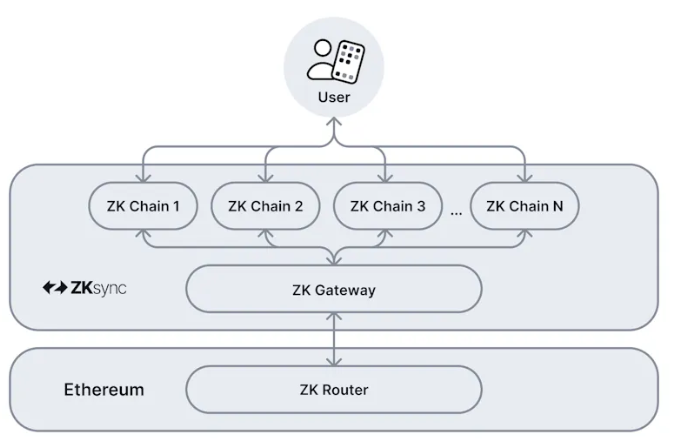Have a nice day everyone, a few days before this writing was shared, ZKsync introduced Elastic Chain. In this blog post, we will examine Elastic Chain through 7 basic questions. Enjoy your reading!
1) What is Elastic Chain?
Elastic Chain is a blockchain network introduced by ZKsync that is continuously expandable and mathematically secured. This network aims to provide users with an easy and intuitive experience.
2) How Did Elastic Chain Emerge?
The use of rollup technology by Ethereum to reduce transaction fees fragmented liquidity and user experience. To solve these issues, the ZKsync 3.0 update was released on June 7, 2024, transforming ZKsync’s L1 bridge into a shared router contract supporting interoperable ZK Chains. Thus, Elastic Chain enabled ZKsync to evolve from a single Ethereum L2 into a network capable of operating with multiple chains.
3) What is the Problem with Multi-Chain?
Despite impressive throughput capacity, the multi-chain ecosystem suffers from significant drawbacks in user experience, capital efficiency, and network integrity. Bridging assets like USDT onto BSC is complex and risky, involving finding reliable bridges, waiting for confirmations, and managing multiple tokens for gas fees. Third-party bridges, while facilitating cross-chain transfers, are prone to hacks and require high liquidity, resulting in significant fees for users. As the number of blockchains and rollups grows, these issues are expected to worsen.

4) How does Elastic Chain work?
The architecture of Elastic Chain consists of three key components: ZK Router, ZK Gateway, and ZK Chains.
ZK Router forms the foundation of the network and is implemented on Ethereum as a series of smart contracts. It manages the state of the network, handles chain registrations, and maintains shared liquidity.
ZK Gateway acts as middleware between Ethereum and ZK Chains, ensuring full interoperability and optimizing interactions. It allows ZK Chains to seamlessly settle on Ethereum by enabling them to submit their proofs and data through Gateway. This provides several advantages, such as reducing L1 verification costs by composing proofs across multiple batches and chains, compressing state differences for smaller batches and forwarding them to L1 in larger, more efficient batches, and ensuring faster finality for low latency cross-chain bridging by verifying chain proofs and preventing equivocation. Each ZK Chain's liveness is independently managed by its validators, so Gateway does not affect it, and chains can leave Gateway network if desired. Additionally, Gateway enhances censorship resistance by making cross-chain forced transactions more affordable. Operated by a decentralized, trustless set of validators using an ERC20 token designated by ZKsync governance, Gateway incentivizes validators with fees for bridging and posting state diff data, ensuring network resilience and reliability while making data settlement cheaper than directly on Ethereum.
ZK Chains, including rollups, validiums, and volitions, are built using the ZK Stack framework. These chains are fully customizable and operate independently but are interconnected via the ZK Gateway and L1 smart contracts, making cross-chain transactions secure and cost-effective. ZK Chains are not required to use the ZK Gateway; they can choose to settle directly to Ethereum and can switch between using the Gateway and settling directly on Ethereum at any time without compromising their security. This flexibility allows ZK Chains to optimize their operations based on their specific needs and preferences.

Let's illustrate this with a real-world example to solidify our understanding: think Elastic Chain as a network of smart homes. ZK Router acts like the control system that manages all devices (chains) and the flow of energy (liquidity). This system monitors for any issues, adjusts settings, and ensures that all devices remain functional. ZK Gateway functions like a command center, coordinating the activities and data transfer between different smart devices (chains) to ensure seamless operation. Each ZK Chain operates like an independent device or room within the smart home, such as lighting, security, or climate control, but remains interconnected, allowing for efficient and secure operation across the entire home network.
5) What are the Advantages of Elastic Chain?
-
Ease of Use: Users can transact across multiple chains using a single address with fast confirmations. Only a single signature is needed, and transaction fees can be paid in any liquid token or be free if sponsored by the dApp.
-
Low Cost: Cross-chain transactions are as cost-effective as those within a single ZK Chain. The number of chains and their capacity can increase without affecting transaction costs.
-
Mathematical Security: All transactions are verified and enforced by Ethereum without relying on honest majority assumptions. In the long term, users will be able to verify transactions using their smartphones.

6) How is User Experience in Elastic Chain?
Elastic Chain offers a seamless and intuitive user experience, making it feel like a single blockchain. Users can onboard with one tap via FaceID or Passkeys, use their crypto-assets across any ZK chain without dealing with bridging or fragmentation, and enjoy fast and cheap transactions enabled by the Ethereum Multi-Chain Address (EMCA) standard. For example, a user can earn $BONSAI through a Lens-powered application and then easily move to a DeFi app offering the best yield, all with minimal effort. This simplicity allows users to focus on the applications they love while benefiting from the interconnected network of ZK chains.

7) How does Elastic Chain look compared to Others?
Since the Elastic Chain concept was introduced at SmartCon 2022 as "Hyperchains without Bridges," various teams have developed their own "chain-of-chains" networks such as Optimism Superchain and Polygon AggLayer. Recent benchmarks using AMM tests with Uniswap V2-style pools measured the throughput of ZKsync Era, Polygon zkEVM, and OP Mainnet. You can find the results of the test in the image:

Conclusion
I hope this blog post has been a useful resource for understanding Elastic Chain and its structure. This writing was prepared with the help of the resource "Introducing the Elastic Chain" shared by ZKsync.